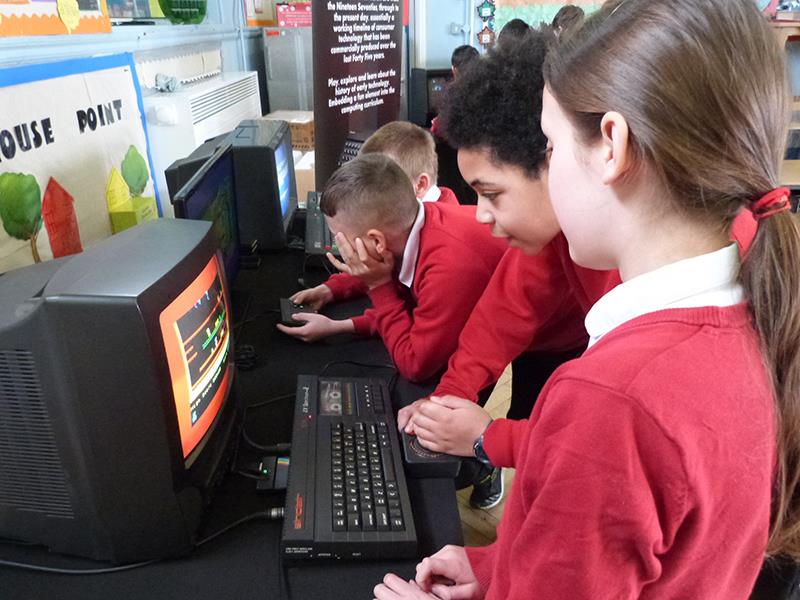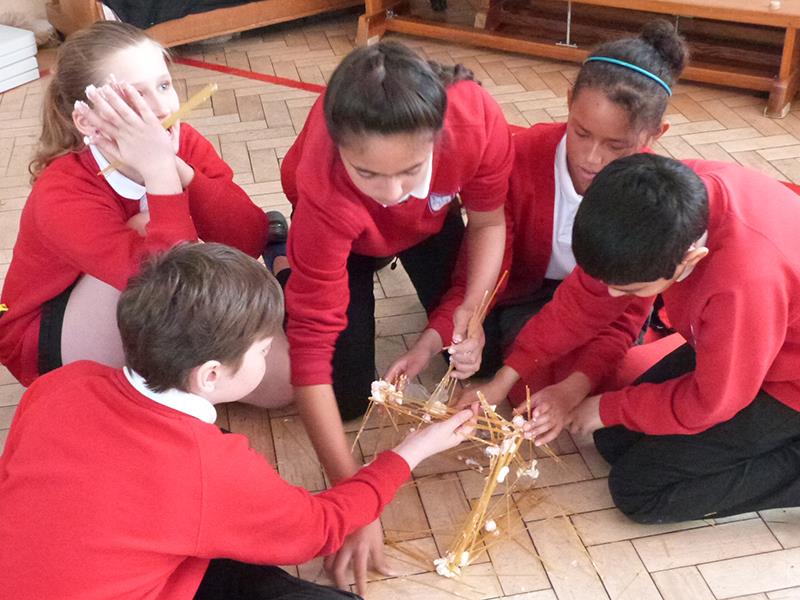British Science Week, which takes place every March, is one of the key dates in the academic year at St Mary Magdalen’s CE Primary School in Lancashire.
This year, our work for the event highlighted areas covering the human digestive system in science, the role British children played in creating the computing and video game industry in technology, structures and design in engineering, representation of pixel art using Hama Beads in art and design and, finally, how art can be seen in different areas of mathematics.
Day one: Digestion
Our week began with the science behind our digestive system. This gives children not only a fun hands-on activity on how the body processes and disposes of food, but also tackles the importance of eating healthy and regular exercise.
By working in groups children simulate the body ingesting solids and liquids. By handling sealed sandwich bags containing fresh orange juice we represent the stomach’s acid lining in breaking down the food we eat. We add fibre, fruit, yoghurt and coffee to and begin to transfer the food through the sandwich bags into tights which simulate the small and large intestines and from there how waste exits the body.
By giving children this hands-on access, they can see how their bodies work on a daily basis and begin to identify the importance of a regular healthy diet and regular exercise in their developmental process. The children thoroughly enjoyed this activity and gives the science curriculum a smelly (and messy!) hands-on activity.

Day two: Computing
Our second day focused on technology and the role British school children played in creating the computing and video game industry in the early 1980s. We had a visit to the school from The CODE Show, a computing museum initiative that I founded myself (alongside my work as St Mary Magdalen’s computing coordinator – see panel opposite for more details).
For this, our school hall was transformed into a museum of computing history with hands-on access to more 15 computers spanning 45 years including historical storage media and 1980s technology that can all fit on a mobile phone today.
During the 1980s British children across the UK adopted the home computer and in turn helped create the digital world we know today. Crucially the computing curriculum makes no mention of this history.
The children were fascinated by the computers and were eager to experience classic software titles created by teenagers such as Manic Miner and Dizzy. By giving them hands-on access they were able to appreciate how “primitive” these machines are. However, they were still eager to explore how to program the machines.
A Sinclair C5 electric vehicle was also on display and led to discussions about Britain’s role in identifying battery and electric transportation as an alternative means to petrol and diesel more than 35 years ago.
On reflection the children’s enthusiasm reminds both pupils and staff that what we are teaching now within the new computing curriculum is not to dissimilar to what the 1980s computing curriculum achieved in preparing children for an ever-changing digital world and the role computers play.

Day three: Engineering
Our engineering focus centred around a visit by an ex-pupil and the local college. We had contacted a former pupil who is now an apprentice at a local engineering firm manufacturing aircraft components.
Key stage 2 pupils looked at how structures are created and how to identify weak points in buildings. By using marshmallows and pasta pupils worked in teams to design a building and collaborate in order to overcome the fragility of the pasta and the flexibility of the marshmallows. This focused the children’s thinking and all the groups managed to create some fantastic structures and overcome the obstacles they faced with the materials provided.
Key stage 1 pupils were guided in groups and given a challenge to create a paper aeroplane that could fly past a set distance. Children were guided on how airflow affects an objects ability to fly through the air.
The children were resilient in overcoming what seemed like an impossible task – with patience and practice they all managed to achieve the end goal. This activity highlighted the role that play has in developing not only social skills (collaboration, team-work) but also problem-solving and working with real-life problems (as faced by engineers every day in industry).
Finally, it was fantastic to see our ex-pupil succeeding in her Apprenticeship within the engineering industry. It was proof for our pupils that with hard work we all can achieve our goals and it was also a good chance to dispel any myths that the children may have held that STEM subjects are just for boys.

Day four: Art and design
In order to fit around the theme of inventions, as a whole school we used pixel art and then moved onto using Hama beads to bring the designs to life. Starting with graph paper and coloured pencils the children came up with some very creative ideas.
It is important for children to be able to express themselves and art is a great subject in encouraging this as there is no “right” and “wrong”. The pupils thoroughly enjoyed this process as they were able to design something of their own choice.
Seeing the finished product was great as you could see the satisfaction of achievement on the children’s faces. Once we had our completed designs, we were able to recreate them using CAD software. This is where the children’s art was transformed, giving us the blueprint to then transfer our 2D designs into 3D printed representations.
Day five: Problem-solving and art in mathematics
Our maths day began with each of our classes using their mathematical knowledge to solve different types of problems. EYFS were using knowledge of number to complete pixel art-type patterns (which revealed different cartoon characters), while key stage 1 used the four operations – addition, subtraction, multiplication and division – to build their very own math monsters.
As for key stage 2, the children had to work in groups to find their way out of “escape rooms” with various problems and riddles to solve using a range of mathematical skills from the four basic operations to ratio and algebra.
It was great to see the children engaging in their challenges with such enthusiasm and using their knowledge and skills collaboratively, particularly the year 4 children who had to solve the clues in order to escape from being “locked” in the multi-use games area! Fortunately, the children knew all they needed to in order to escape and get back into class safely, ready for the afternoon session.
After a morning of numbers and problem-solving, the afternoon allowed the children to be a little more creative and explore art through maths. EYFS to year 3 looked at the work of Piet Mondrian, with his use of primary colours and simple rectangular forms, while years 4 and 5 found out how straight lines can be used to create parabolic curves (the children could not believe how this worked!). They then used this to create their own interesting, original patterns.
In year 6, fractal patterns were the initial focus. Though impossible to draw fractals with infinitely small patterns, the children drew shapes which looked like fractals onto nets of square-based pyramids. The children were allowed to be as creative with their patterns as possible and produce as many nets as they were capable of, though they were not told exactly why they required so many pyramids.
Once their nets were assembled, the children were then told they were to use them to build a Sierpinski Pyramid – a fractal with the overall shape of an equilateral triangle, subdivided recursively into smaller equilateral triangles. Once all the children had their own Sierpinski Pyramid, they then joined them together to build one giant pyramid.
Throughout the afternoon, the different activities allowed for children to discuss their thoughts and share ideas, both with each other and the adults involved, as well as reflect on their morning of problem-solving.
The CODE Show
The CODE Show was founded to give schools hands-on access to historical technology. It showcases the UK’s role in creating the digital world we know today.
I was frustrated at the rising costs of coach travel and logistical barriers in taking a class to the Computing Museum in Cambridge and so I bought more than 300 historical machines and technology spanning five decades in the belief I could offer schools a viable alternative in their own setting.
With our visit we can explain to children that what we are teaching in computing is not new. By giving them hands-on access to our collection they can see how early technology has evolved. In retelling the story of how Britain adopted the home computer and subsequent home computing boom of the early 1980s we can illuminate the missing piece in the computing curriculum while also celebrating our past and inspiring new generations of learners.
- Gary McNab is computing coordinator at St Mary Magdalen’s CE Primary School in Accrington. This article has been compiled with support from the staff at St Mary Magdalen’s
Further information & resources
- British Science Week is organised by the British Science Association and takes place next in March 2020. Visit www.britishscienceweek.org
- For more details, visit www.thecodeshow.info, email hello@thecodeshow.info or follow @The_CodeShow on Twitter.
